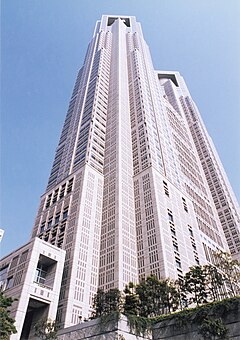
- 東京は大きく「23区」「多摩地方」「島」に分けられます。この記事は、外国人(そして多くの日本人)が「東京の街」と考えている東京23区についてです。日本、多摩地域、および島々の都道府県としての東京の詳細については、を参照してください。 東京都.
- ザ・ 東京2020 この記事は、2021年のXXXII夏季オリンピックのより具体的なガイドを提供します。
東京 (東京東京)はの巨大で裕福な首都です 日本、そしてまたその主要都市であり、文化、商業、そして何よりも人々で溢れています。世界で最も人口の多い都市部である東京は、魅力的でダイナミックな大都市であり、外国の影響、消費者文化、グローバルビジネス、そして旧日本の首都の名残が混ざり合っています。近代的な電子機器やきらめく高層ビルから桜や皇居まで、この街は日本の歴史と文化の全貌を表しています。東京は本当にすべての旅行者のために何かを持っています。
地区
まず、いくつかの簡単な定義。日本の首都は都市ではありませんが、実際には 東京都 (東京都 東京都)、名前は別として都道府県と見分けがつかない:他の46都道府県と同等のステータスで、ほぼ同じ大きさ(西の大きな郊外や地方、さらには1,000 kmまでの島々を含む)( 620マイル)南)。さらに不思議なことに、「東京の街」というものはありません。 「東京」と聞いて、外国人も日本人も、ほとんどの人が考えているのは 東京23区 (特別区 徳別区)、時々単に 23区 (23区 二十三区)。それらをまとめる「市政府」がないことを除けば、それらはロンドンやニューヨークの自治区にいくぶん似ています。区は英語で「都市」と呼んでいますが(そのように振る舞い、それぞれに市長と評議会があります)、混乱を避けるために、ほとんどの人はそれらを「区」と呼ぶことを好みます。
この記事は23区についてですが、西部の郊外と島々は 東京都.
東京都心の地理は、JR山手線によって定義されています(参照 移動する)。将軍とその武士のために予約されていた東京の中心部はループ内にあり、江戸時代の繁華街(下町) 下町)は北と東にあります。四方八方に広がり、シームレスに溶け込む 横浜, カワサキ そして 千葉、東京の郊外。合わせて、大都市圏全体の人口は4,000万人を超え、世界で最も人口の多い都市部となっています。
東京都心
| 千代田 を含む日本の権力(政治的および経済的の両方)の席 皇居、霞が関近郊の省庁、永田町議会、丸の内本社、電子機器のメッカ 秋葉原. |
| 中央 の有名なデパートも含まれています 銀座 との外部市場 築地. |
| 湊 のビジネスセンターを含む 赤坂 そして 新橋 と隣接するナイトクラブ地区 六本木、人工島を含む港湾地区(少なくとも名前では) お台場、およびの高層ビル 汐留. |
| 新宿 高級ホテル、巨大なカメラ店、未来的な高層ビル、何百ものショップやレストラン、そして 歌舞伎長、東京で最もワイルドなナイトライフと歓楽街。 |
| 渋谷区 ティーニーボッパーの天国も含むファッショナブルなショッピング地区 原宿 (また、 明治神宮)とのナイトライフ 恵比寿 |
| 品川 を含む主要な鉄道ハブとビジネスセンター 大井町線 そして 五反田. |
| 豊島 もう一つの巨大な列車のハブである池袋を含みます。 |
| 目黒 いくつかの素敵な公園や美術館がある住宅街。 |
旧東京(下町)
| スミダ 今、現代の存在で優雅に 東京スカイツリー、この病棟は 江戸東京博物館 両国にある東京の主要な相撲館(両国国技館)。 |
| 台東 の寺院が特徴の旧東京の中心部 浅草 そして 国立博物館 に 上野、そして東京で最も安い宿泊施設のいくつか。 |
| 文京 東京ドームと東京大学の本拠地。 |
郊外

| 東 を含む多くの郊外の病棟 足立、関東の三大寺院の1つ、西新井大師を訪れることができます。 葛飾、昭和の魅力的な雰囲気で知られる 柴又;そして 江戸川、静かな東部郊外。また、 豊洲 月地に取って代わった魚市場。 |
| 北 の郊外区を含む 北, 板橋 そして静かな北部 練馬、23区の最後に残っている農地のいくつかが含まれています。 |
| 中野 の本拠地 オタク 中野ブロードウェイとして知られる楽園。 |
| 太田 半分は工業団地、半分は高級住宅地、羽田空港の本拠地。 |
| 世田谷 の学生飲酒スポットを収容する高級住宅街 下北沢 新しく活性化されたショッピングセンターと同様に 二子玉川. |
| 杉並 中央本線に沿って伸びる典型的な東京郊外。 西荻久保数多くのアンティークショップで有名な、がこのエリアにあります。 |
理解する
500年以上の歴史を持つ東京は、かつてはささやかな漁村でした。 江戸 (江戸-文字通り 川の門)隅田川の河口に位置しているため。この都市は、1603年に徳川幕府の本拠地となり、宮廷の陰謀から遠く離れた場所に新しい権力の座を設置することを決定したときに初めて、真に成長し始めました。 京都。徳川家が影響力を失った1868年の明治維新後、天皇と皇室は京都からここに移り、現在の名前である東京、文字通り「東の首都」に改名されました。国の首都である東京は、ビジネス、教育、現代文化、そして政府の目的地です。 (それは、 大阪 それらの主張に異議を唱えることはありません。)
文化

東京は 広大:それは単一の都市としてではなく、一緒に成長した都市の星座として考えるのが最善です。東京の地区は、電子的なブレアから、性格によって大きく異なります 秋葉原 の帝国庭園や神社へ 千代田、の活動的な若者文化のメッカから 渋谷区 の陶器店や寺院の市場へ 浅草。見た目が気に入らない場合は、電車に乗って次の駅に行くと、まったく違うものが見つかります。
東京の巨大なサイズと熱狂的なペースは、初めての訪問者を脅かす可能性があります。街の大部分はコンクリートとワイヤーのジャングルで、ネオンと大きなスピーカーがたくさんあります。ラッシュアワーには、群衆が満員電車で喧嘩し、人類の大衆が巨大で途方もなく複雑な駅を通り抜けます。あなたのリストから観光スポットをチェックすることにあまり夢中にならないでください:ほとんどの訪問者にとって、東京の経験の大部分はただランダムに歩き回って雰囲気を吸収し、奇妙で素晴らしいものを売る店に頭を突っ込み、レストランを試食することですメニュー(またはお皿)で一つもわからず、近所の神社の静かな敷地で思いがけない落ち着きのあるオアシスを見つけます。それはすべて完全に安全です、そしてあなたがただ尋ねるならば、地元の人々は時々あなたを助けるために並外れた長さに行きます。
経費
東京での生活費はかつてほど天文学的なものではありません。デフレと市場の圧力は、東京のコストを先進国の他のほとんどの大都市に匹敵させるのに役立っています。からの訪問者 サンフランシスコ, ロサンゼルス, ニューヨーク, シカゴ, ロンドン, パリ, シドニー, トロント そして ダブリン 家に帰るよりも高価だとは思わないでしょう。旅行者は、東京での滞在に、他の大都市と同じ金額の予算を立てる必要があります。 ヨーロッパ, 北米 または オーストラリア。地元の人は掘り出し物を知っていますが、世界中のどこからでも経験豊富な安いスケートは少しの工夫でやっていくことができます。東京は日本で最も人気のある場所の1つです。シングルのアパートの家賃は月額500ドルから1,000ドルの範囲である可能性があります。東京は圧倒的に混雑しているため、多くの人が16平方メートル(175平方フィート)以下のアパートに住んでいます。とはいえ、東京とその周辺の交通機関は良好で、東京の中心部から5分離れた場所に住むと、毎月の生活費が数百ドル少なくなるか、より大きな住宅が可能になります。千葉県、埼玉県、神奈川県、茨城県の多くの地域で、「東京に住んでいる」という感覚が得られるかもしれません。それでも、目覚め、すぐに外に出て都会の生活に入るという点で、東京自体に匹敵するものはありません。
気候
| 東京 | ||||||||||||||||||||||||||||||||||||||||||||||||||||||||||||
|---|---|---|---|---|---|---|---|---|---|---|---|---|---|---|---|---|---|---|---|---|---|---|---|---|---|---|---|---|---|---|---|---|---|---|---|---|---|---|---|---|---|---|---|---|---|---|---|---|---|---|---|---|---|---|---|---|---|---|---|---|
| 気候チャート(説明) | ||||||||||||||||||||||||||||||||||||||||||||||||||||||||||||
| ||||||||||||||||||||||||||||||||||||||||||||||||||||||||||||
| ||||||||||||||||||||||||||||||||||||||||||||||||||||||||||||

東京は湿潤亜熱帯気候帯にあると分類され、5つの異なる季節があります。
- 春 2月下旬に梅の花で始まり、有名な桜が続きます(さくら)3月〜4月。公園、最も有名な 上野、青い防水シートとびしょ濡れのサラリーマンでいっぱいになります。
- 梅雨 (バイウ または ツユ)5月下旬から6月は、20代の気温で、曇り空と霧雨が土砂降りで中断された1か月を意味します。
- 夏 本当に7月に始まります。晴天ですが、気温は30代の高さでピークに達し、スチームバスの湿度は残酷です。外を少し歩くだけでも汗だくになるので、これはおそらく一年で最悪の時期であり、選択肢があれば避けるのが最善です。 1つの明るい点は 花火、特に7月の第4土曜日に開催される隅田川花火大会の壮大な花火の祭典。
- 秋 9月以降は気温が下がり、紅葉することを意味します。この時期、日本南部は定期的に台風に襲われますが、台風はほとんど(常にではありませんが)東京を避けています。
- 冬 通常は穏やかで、気温は通常0〜10°Cの範囲ですが、時折寒い時期に気温が0度を下回ることがあり、室内の暖房には多くの要望が残される可能性があります。雪はまれですが、東京が吹雪に見舞われる数年に一度のまれな機会に、列車のネットワークの多くが停止します。
トーク
英語を話す人は、日本語を話さなくても東京を移動することができます。地下鉄や駅の標識には、駅名が含まれています。 ローマ字 (ローマ字)、およびより大きなステーションには、中国語と韓国語の記号が付いていることがよくあります。 40歳未満のほとんどの人は学校で英語を学びましたが、一般的に習熟度は低く、ほとんどの地元の人々はいくつかの基本的な単語やフレーズしか知りません。一部のレストランでは英語のメニューがあるかもしれませんが、それは必ずしもスタッフが多くの英語を話すことを意味するわけではありません。しかし、読み書きははるかに良くなり、多くの人々は実際にそれを話す方法を知らなくても、書かれた英語をたくさん理解することができます。そうは言っても、主要なホテルや観光名所のスタッフは、一般的に許容できるレベルの英語を話します。英語だけで済ませることは可能ですが、基本的なことを学べば、旅行はずっとスムーズになります。 日本語.
入れ
日本では、すべての道路、鉄道、輸送レーン、飛行機が東京に通じています。
飛行機で
東京 (TYO IATA すべての空港)と関東地方には、2つの大きな空港があります。成田(NRT IATA)は東京の国際線の主要ハブですが、特に格安航空会社での国内線の数も少なく、北米、ヨーロッパ、中東からほとんどのアジアの主要都市へのトランジット空港として便利です。羽田(HND IATA)は、東京の中心部にはるかに近く、主に国内線から国際線に拡大およびシフトしており、2020年半ばまでに、ビジネストラフィックが多い多くの大都市にサービスを提供する予定です。
最終目的地が東京または神奈川地域の場合、羽田へのフライトは東京とその周辺に行くのにはるかに便利で経済的です。
成田空港
- 主な記事: 成田国際空港
1 成田国際空港 (NRT IATA;成田国際空港 千葉県立成佐). の町の近く 成田 東京の東約70km(43マイル)。東京へのほとんどの国際線と国内線の限定便を、主に格安航空会社で運航しています。
東京に行くには、あなたはあなたの選択があります 電車、高速を含む 京成 スカイライナー (2520円、日暮里駅まで36分)、 JR 成田エクスプレス (JRパスで3070円または無料、東京駅まで55分)、安い京成 Access Express (1時間から 浅草、¥1310)。他の方法には、 空港リムジンバス、荷物が多い場合(東京都エアターミナルまで90分、2800円から)で安いので便利です 低コストのバス (東京駅まで75分、1000円)。
羽田空港
- 主な記事: 東京羽田空港
2 東京羽田空港 (HND IATA;羽田空港 羽田空港 または東京国際空港 東京国外国光). 東京都心の南14km(8.7マイル)の大田区に位置する、日本で最も混雑する空港であり、アジアで2番目に混雑する空港。ほとんどの国内線に就航しており、2010年以降の拡張により、主にビジネストラフィックの多いルートで、ますます多くの国際線に就航しています。
東京への最も簡単な方法は、 列車、いずれか 東京モノレール (500円またはJRパスで無料、15分)または 空港線 東京をまっすぐに渡ることができます(11〜15分 品川, ¥300). 空港リムジンバス 主要なホテルや鉄道駅(¥840-1020)に直行します。 タクシー 4000〜10000円かかります。どちらも列車が運行されていない夜間に利用できますが、追加の夜間追加料金がかかります。
茨城 空港
3 茨城空港 (IBR IATA;茨城空港). に 小美玉, 茨城、東京の北約85 km(53マイル)にある茨城空港は、格安航空会社を真正面から狙っています。スカイマークは国内線を運航しています 札幌, 神戸, 福岡 そして 沖縄。春秋航空は、 上海 そして 西安、そしてタイガーエアはに飛ぶ 台北。フジドリームエアラインズが運営する他の国内都市へのチャーターサービスもあります。
茨城空港と東京の間を移動する最良の方法は、関鉄バスが1日に数回運行するバスサービスです。所要時間は約2時間半で、飛行機の乗客は500円、飛行機以外の乗客は1530円です。予約が必要で、無料の英語予約が可能です オンライン。バスに乗るときに料金を支払う必要があります。距離と時間はかなりのものですが、茨城空港経由のトランジットは、出発地域と季節によっては、フライトで数百ドル、さらには数千ドルの節約になる可能性があることに注意してください。さらに、税関と入国管理は主要空港に比べて非常に速いです。また、茨城空港には、日本で運転している可能性のある人に会う場合に考慮すべき、非常に高速で完全に無料の駐車場があります。
ジャパンレールパスを利用する場合でも、すぐ近くに両替所はありません。バスに乗って東京駅まで行き、そこの交換所に行くのが一番です。
調布飛行場
4 調布飛行場 (いいえIATA、ICAO: RJTF;調布飛行場 調布飛行場). ターボプロップ機の一部のフライトのみを提供します 伊豆諸島 東京の南。
最寄り駅は京王線西調布駅まで徒歩15分です。または、からバスに乗ることができます 調布 または 三鷹 ステーション。
電車で

東京は日本の鉄道の中心地です。高速 新幹線 サービスはに到着します 5 東京駅(東京駅東京都駅) にあります 千代田 区。北ルートのすべての列車は、次の場所で下車できます。 上野、西ルートの列車が 品川。新幹線以外のほとんどのサービスは通常、 渋谷区 そして 新宿 駅も。上野と 池袋 駅は北部の郊外や近隣の都道府県に接続しています。
から1時間ごとに複数の出発があります 京都 そして 大阪 3種類の新幹線で東京へ。ザ・ のぞみ 大阪から電車で2時間半かかる最速です。ザ・ ひかり より多くの停止を行い、3時間かかります。 児玉 は最も遅く、すべての停車地を作り、4時間で東京に到着します。ザ・ のぞみ 電車はジャパンレールパスの対象外.
北からの複数の都市は、東京への直接新幹線サービスを提供しています。 秋田, 青森, 福島, 函館, 金沢, 盛岡, 長野, 名古屋, 新潟, 仙台, 富山, 山形 そして 湯沢。これらの都市からのすべての列車は、 埼玉その後、南に向かって上野駅と東京駅に向かいます。
日本は高速の新幹線が支配的ですが、まだいくつかの寝台列車が残っています。 サンライズ出雲 (サンライズ出雲)は毎日東京から 出雲 一方 サンライズ瀬戸 (サンライズ瀬戸)とつながる 高松、で最大の都市 四国 島。両方の列車は東京と 岡山.
車または親指で
街に車で行くことはできますが、街が混雑している可能性があり、標識が混乱している可能性があり、駐車料金が天文学的なものであるため、実際にはお勧めできません。考慮すべきオプションの1つは、東京に隣接する都市の24時間駐車場が安いことです。たとえば、八潮市の駅は 埼玉県 1日500円で何百ものスペースがあり、北千住や秋葉原からわずか数分。人の車は電車で旅行する一人一人の価格の何分の1かで高速道路で旅行することができ、東京への最も安い列車の切符で最後の足を取ることができます。日本を旅行する3〜5人の観光客のグループにとって、東京発着のレンタカーを別の都市の代理店カウンターに返却することは、電車や飛行機での旅行に比べて節約の大きなチャンスになるかもしれません。
東京へのヒッチハイクはとても簡単ですが、ヒッチハイクはかなり難しいです。決心したチープスケートは間違いなく可能ですが、を参照してください。 日本でのヒッチハイク 都市からのテストされた脱出ルートの詳細なリストについては。
バスで
高速バスサービスは、東京と他の都市、リゾート地、および周辺の都道府県を結んでいます。 JRと民間バス会社があります。バスサービスの方が安いかもしれませんが、電車の方がおそらく便利です。 JRパスをお持ちの場合は、通常、電車を利用する必要があります。
長距離バスは市内に点在する多数のターミナルを利用しています。東京駅のバスの主な乗車場所は 八重洲出口 (八重洲口)東側。に 新宿、ほぼすべてのサービスが新しいサービスを使用しています 6 バスタ新宿、省略形 バスタ新宿 (バスタ新宿)、新宿駅のJR線路の上にあります。
- JRバスグループ -東京発着のバスサービスの大手オペレーター。 JRバスの座席予約は、東京駅と新宿駅のJRバスカウンター、およびJR駅の列車の座席予約と同じ「みどりの門口」の切符売り場で行うことができます。 ジェイアールバス関東 そして ジェイアール東海バス バスのオンライン予約を英語で提供します。
- ウィラーエクスプレス -東京発着のバスを毎晩運行している会社。そのバスサービスは日本の多くの都市を結んでいます。オンライン予約は英語でご利用いただけます。
- 国西工業バス(日本語サイト).
- 京成バス(日本語サイト).
- 京急バス(日本語サイト).
- 京王バス(日本語サイト).
- 関東バス(日本語サイト).
- 西東京バス(日本語サイト).
- 小田急バス(日本語サイト).
- 小田急箱根バス.
- 西武バス(日本語サイト).
- 東武バス(日本語サイト).
- 東北急行バス(日本語サイト).
船で
世界の素晴らしい港の1つである東京には、日本の他の地域への国内フェリーサービスもあります。しかし、日本への定期的な国際フェリーはどれも東京に寄港していません。
主な長距離フェリーターミナルは 7 東京港フェリーターミナル、隣接する人工島 お台場 東京湾で。最寄り駅はゆりかもめ線の東京・天地城・西門ですが、まだ少しハイキングです。東京メトロ有楽町線新木場駅から直行バスもご利用いただけます。このターミナルからの主なサービスは次のとおりです。
- 川崎近海汽船 (川崎近海汽船), ☏ 81 3-3528-0718. このフェリーには旅客施設がないため、車を持っている場合にのみ使用できます。 車とドライバーの料金は25,820円から.
- オーシャン東急フェリー (遠東九行), ☏ 81 3-5148-0109. 東京・北九州の旅客運賃は、2等車が16,420円、1等車が30,550円です。.
へのフェリー 伊豆 そして 小笠原諸島 を発つ 竹芝ターミナル (竹芝客船ターミナル)、ゆりかもめ線の竹芝駅に隣接。クルーズ客船は 晴海ターミナル (晴海客船ターミナル)、東京駅丸の内南口からバス都05(To-05)、または東京駅八重須出口からバス東12(Tou-12)でアクセスするのが最適です。乗客も乗船する国際フェリーや貨物フェリーは、他のターミナルからも出航できます。運送会社にお問い合わせください。
移動する
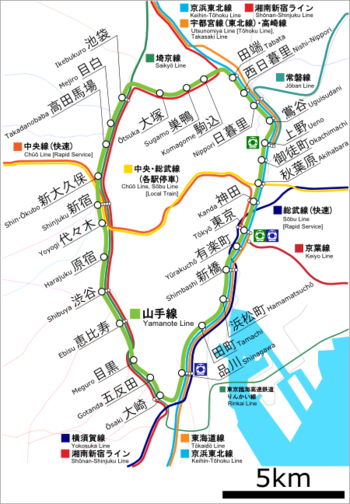
電車と地下鉄で
東京は、世界で最も広範な大量輸送システムの1つであり、年間の乗客数の点で世界で最も使用されている地下鉄システムです。それはクリーンで安全かつ効率的であり、混乱を招きます。混乱は、JR東日本ネットワーク、2つの地下鉄ネットワーク、さまざまな専用線など、いくつかの異なる鉄道システムが東京内で運行されており、ルートマップが異なればシステムも異なるという事実から生じます。可能であればラッシュアワーは避けてください。電車は非常に混雑しやすいです。
東京を代表する鉄道はJR 山手線 (山手線 山手線)、東京の中心部をループで走っています。山のループの中にいることは、東京の中心にいることと同義です。ほぼすべての地域間JR線と専用線は山手線の駅から出発しています。 JRのラインは色分けされており、山音は ライトグリーン。 JR 中央線 (オレンジ、中央線 中央本線)および 中央総武線 (黄、中央・総武線 中央総武線)Yamanoteループを二等分して並べて実行します。 新宿 西に 東京 東に。 JRの他の通勤路線である西京と京浜東北は、山手線の縁から南北に走っています。 JR東日本には、050-2016-1603または03-3423-0111という英語の情報ラインがあります。

東京には広大な 地下鉄 アジア最古のネットワークで電車が頻繁に運行されているネットワークで、主に山手線内を移動するのに便利です。ザ・ 東京メトロ 銀座、丸の内、日比谷、東西、千代田、有楽町、半蔵門、南北、福東新の9路線を運行しています。 東映 浅草、三田、新宿、大江戸の各路線を運営しています。 JR山手線は地下鉄ではありませんが、東京の繁華街の主要な交通機関として重要であるため、通常は地下鉄路線図に掲載されています。また、大部分が地下にあるりんかい線は、 東京臨海高速鉄道 (TWR)、それはの島を通過します お台場.
アナウンスとサインは通常日本語と英語のバイリンガルですが、観光客が頻繁に訪れる地域では韓国語と中国語のサインも見られます。とはいえ、駅で働くスタッフが英語を話すことはめったにありません。
の数 専用通勤路線 山音ループから郊外の区や郊外に放射状に広がり、ほとんどすべてがループ内の地下鉄路線に直接接続しています。専用線は市外の日帰り旅行に便利で、JRより少し安いです。これらの中で、訪問者にとって最も重要なのは間違いなく ゆりかもめ 島への途中で素晴らしい景色を眺めることができます お台場.
それが 電話で話すのは失礼 電車に乗っている間。代わりに、サイレントモードに切り替えながら、代わりにテキストメッセージを送信する必要があります。エスカレーターをご利用の際は、 左側に立つ 急いでいる人はあなたを右側に追い越すことができます。
運賃と時間

ほとんどのチケットとパスは自動販売機から販売されています。これらのマシンは 現金のみ しかし、変化を与えてください。 JRの電車はジャパンレールパスで無料です.
プリペイド運賃カード 運賃を決めるために時々日本語のみの運賃マップを読まなくても電車に乗ることができるので、便利で強くお勧めします。プリペイド運賃カードには、JR東日本の2つのブランドがあります。 Suica、および PASMO、専用(非JR)回線によって提供されます。機能的には完全に交換可能で、東京のほぼすべての地下鉄、電車、バスの路線で使用できます(新幹線と限定急行列車を除く)。ただし、SuicaカードはJR東日本でのみ返金可能ですが、PASMOカードは、訪問終了時に返却を希望する場合に限り、JR以外のオペレーターのみが返金できます。それらは最後の取引から10年間有効であるため、次の旅行のために保持することもできます。
運賃カードは充電式の「スマートカード」です。改札口の横にあるタッチパッドでカードをタップするだけで、出入りするときに同じ操作を行うことができます。運賃カードを購入する際に最初に500円の保証金を支払う必要がありますが、1枚のカードに最大20,000円の金額を保存できます。 (「運賃カード」という用語は多少誤解されています。SuicaとPASMOは一般的なプリペイドデビットカードであり、自動販売機から一部のショップまで、他のサービスで支払いとして受け入れられます。日本を離れるときは、空港のレストランや免税店で簡単に利用できます。)日本の他の場所から来る場合は、関西のICOCAや北海道の北賀など他のほとんどの地域のスマートカードSuicaやPASMOと互換的に使用できます。ただし、東京では返金できませんので、返金を希望される場合は、それぞれの地域に戻る必要があります。
年上の パスネット カードはご利用いただけなくなりました。これらのいくつかをまだ所有している場合は、それらを交換することができます PASMO または Suica カード。
無制限の旅行を許可するいくつかの特別なチケットもありますが、電車で半日を過ごすことを計画していない限り、ほとんどは観光客に役立つ可能性は低いです。
- 東京地下鉄パス:1(800円)、2、3日パスは他のコンボと一緒にご利用いただけます。
- ザ・ 徳内峠 (都区内パス)は、東京23区(山手線全体とその周辺の多くの駅を含む)のJR線での旅行に適した1日パスです。料金は750円で、1日に5回以上電車に乗るなら経済的です。バリアントは 徳内フリーキップ (都区内フリーきっぷ)。周辺県の駅から東京への往復も含まれます。ザ・ モノレールと徳内無料キップ羽田空港から東京都心までの往復が含まれる2日間の料金も2,000円で販売されています。
- ザ・ 東京フリーキップ (東京フリーきっぷ)は、23区内のすべてのJR、地下鉄、市内バスの路線をカバーしています。 1日1,580円で、六本木やお台場など、JRがサービスを提供していないエリアがたくさんあります。
- ザ・ ホリデーパス (ホリデーパス)は、千葉、神奈川、埼玉、東京都西部を含む首都圏のJRネットワーク全体をカバーしています。 1日2,300円で、週末・祝日・夏休み(7月20日〜8月31日)のみご利用いただけます。
誰が英語で発表していますか? 東京では、JR東日本、東京メトロ、東武地下鉄、東武鉄道、西武鉄道、小田急電鉄、京成電鉄のどの電車でも、同じような声で英語のアナウンスが聞こえますが、実際はすべて同じ声優が発表し、 クリステル・チアリ. 彼女は日本のインタビューで、「私が働いていたほとんどの鉄道会社は、駅名を英語で発音する方法を教えてくれなかった。それで、個人的にはもっと自然だと思ったので、元の日本語のアクセントで読むことにした。英語を母国語としない人にとっては理解しやすい。唯一の例外はJREastで、駅名をアメリカのアクセントでアナウンスするように指示された。」 そのため、東京メトロでは「渋谷」、JRでは「シーブーヤ」と聞こえます。 |
あなたが支払っている場合 アラカルト、地下鉄、電車の料金は距離に基づいており、東京都心内のホップは110円から310円です。経験則として、東京メトロ線が最も安く、都営線が最も高く、JR線は中間のどこかにあります(ただし、通常、メトロよりも短い旅行、つまり4駅以下の場合は安いです)。専用線の多くは地下鉄と相互運用しているため、同じ電車に乗っているにもかかわらず、本質的に別の線や運賃体系に乗り換えているため、1回の乗車が不当に高額に見えることがあります。例えば。地下鉄と東急専用線を乗り換えると、それぞれの運賃の合計が支払われます。最低運賃メトロ160円最低運賃東急120円= 280円。また、「乗り換え割引」にはいくつかの乗り換えパターンが記載されており、最も有名なのは東京メトロと都営地下鉄間の乗り換えに適用される70円割引です。 SuicaまたはPASMOをご利用の場合、すべての振込割引を自動的に受けることができます。一部の乗り換え駅では、オレンジ色の特別な乗り換えゲート(紙のチケットとPASMO / Suicaの両方)を通過する必要がある場合があります。通常の青いゲートを通過しても、転送割引は受けられません。紙のチケットをお持ちの場合は、あなたはそれを取り戻すことはありません。一部の乗り換え地点(浅草駅など)では、2つの駅(メトロ銀座線と都営浅草線)が物理的に接続されておらず、約1ブロック離れているため、実際には通りの高さで乗り換える必要があります。
事前にルートを確認するのは有料です。ザ・ 観光客のための東京地下鉄ナビゲーション 東京メトロのモバイルアプリで、時間、費用、乗り換えに基づいて、A地点からB地点までの地下鉄や電車の旅を計画できます。このアプリは東京のみの情報を提供します。全国をカバーする他のアプリやサイトについては、 日本 ページ。
目的地までの距離がわからない場合は、最も安いチケットを購入して、自動精算機で差額を支払うことができます(のりこし) 最後に。ほとんどの自動販売機では、JR、地下鉄、専用線の間の目的地までの乗り換えをカバーする単一のチケットを購入できますが、システムに慣れていない場合は、これを行う方法を理解するのは難しいかもしれません。チケットまたはスマートカードで支払うかどうかにかかわらず、システム間で転送するときは、 オレンジ色のトランスファーゲート 出る。それ以外の場合は、より安い送迎料金ではなく、旅行の両方の別々の部分に対して全額が請求されます。
東京のほとんどの電車は05:00から01:00頃に運行しています。ピーク時には、約3分に1回実行されます。オフピーク時でも電車の間隔は10分未満です。通常の旅客サービスが夜間に運行される唯一の夜は、一部の路線の年末年始です。
一般的な日本での電車旅行の詳細については、以下を参照してください。 列車で のセクション 日本 論文。
タクシーで

タクシーは非常に高価ですが、3人以上のグループにとっては価値があるかもしれません。また、終電に乗り遅れた場合、他に選択肢がないかもしれません。
タクシーを短距離の旅行でより魅力的にするために、2017年に運賃が改定されましたが、長距離の旅行は依然として非常に高額です。標準タクシーの料金は、最大1 km(0.62マイル)で410円から始まり、停車中または低速の交通では237メートル(0.147マイル)ごとに80円ずつ上昇します。 22:00〜05:00には20%の夜間追加料金が課せられ、高速道路を使用するすべての旅行には料金が追加されます。
日本交通のタクシー料金の見積もりに基づく日中の料金の例を次に示します(実際の料金は異なる場合があります)。
- 東京駅から秋葉原駅まで-2.5km(1.6マイル)-1140円
- 東京駅から新宿駅(バスターミナル)-7.1 km(4.4マイル)-3060円
- 東京駅から羽田空港第1ターミナルまで-22km(14マイル)-高速道路料金込みで8000円
Taxi rear left passenger doors are operated by the driver and open and close automatically. Don't open or close them yourself.
Do not count on your taxi driver speaking English—or knowing more than the best-known locations, though most taxis have GPS "car navi" systems installed. The best and easiest thing to do is to prepare a map marked with where you want to go, and point it out on the map to the taxi driver. If you are staying at a hotel, they will provide a map. If possible, get a business card, or print out the address in Japanese of any specific places you wish to go. However, because in Japan streets are often unmarked, if the taxi driver does not have GPS he may not be able to do more than take you to the general vicinity of where you want to go. Also, taxis can get caught in traffic jams. No tips are expected or given.
Nihon Kotsu has a 24-hour English telephone number, 03-5755-2336, to call for a Nihon Kotsu taxi within Tokyo. There is a booking fee payable to the driver at the end of the trip: ¥410 for an immediate hail or ¥820 for an advance booking. If you already have a destination (or a few) in mind, the receptionist will electronically transmit the information to the driver so that you don't have to tell the driver yourself. If you are hailing a taxi right away, the English receptionist will inform you about your assigned taxi by color, company name and taxi number.
A growing number of companies in Tokyo also offer taxi hails and ride requests by mobile app. Your hotel's front desk can also call a taxi for you, subject to the same booking fees.
車で
Tokyo is a gigantic warren of narrow streets with no names, with slow-moving traffic and extremely limited and expensive parking. In this city with such an excellent mass transit system, you would need a good reason to want to drive around instead. While renting a car can make sense in Japan in some contexts (e.g., visiting a rural onsen resort), in general it is neither convenient nor economical to rent a car to get around metro Tokyo. Taxis are much more convenient if your budget allows it; walking or public transportation is much less expensive and given the difficulties of navigation and finding parking in popular areas, probably easier too.
If you do decide to plunge in and drive around by car, the main expressway serving Tokyo is the Shuto Expressway, abbreviated to Shutoko (首都高). The C1 Loop Line forms a circle around central Tokyo, similar in fashion to how the Yamanote Line does it by rail. But whereas the Yamanote Line charges ¥140-200 for a single trip, driving a car onto the Shutoko in Tokyo costs ¥1320every time you enter the system (compact cars slightly cheaper), with additional tolls collected at various other locations. Vehicles equipped with Electronic Toll Collection (ETC) tags pay a cheaper rate based on the distance driven.
Driving on the Tokyo Expressway at night can be a pleasant and beautiful experience as you whiz through and around the Tokyo nightlife. When driving at night you should exercise caution and obey speed limits: Street racing over the Shutoko at night became popular in the 80s and 90s and still happens today, albeit on a less frequent basis. Street racers often concentrate their driving on the C1 Loop Line and the Bayshore (more popularly known as the Wangan) Line. "Competitors" sometimes hang out at parking and service areas on the Shutoko, especially the large Daikoku Parking Area at the intersection of the Bayshore Line and the K5 Daikoku Line in 横浜.
バスで
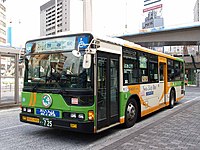
The few areas within Tokyo that aren't easily accessible by train are served by various bus companies. Buses operating within 23 wards of Tokyo have a fixed fare regardless of distance (¥210 on Toei buses and ¥220 on other private bus companies), which is paid upon boarding from the front door. The fares are not transferable; however most buses do accept Suica または PASMO fare cards (see above). If you use a "Suica" or "PASMO" card to board a Toei Bus, you will receive a ¥100 discount on your next Toei Bus ride as long as it is within 90 minutes of the previous ride. Compared to the trains, the buses run much less frequently, carry fewer passengers, and are much slower. This makes them amenable to the elderly residents of Tokyo, but rather inconvenient for travelers, who will also have to deal with lack of information in English and sometimes very well hidden bus stops. Bus routes can be fairly complicated and are often not listed in detail at the bus stops; signs on the buses themselves often list only two or three main stops in addition to the origin and destination. Inside the bus the next stop is usually announced several times, sometimes by a taped voice and sometimes by a mumbling driver. Taped announcements in English are used on some lines, but are still rare. Nevertheless, north–south routes are useful in the western side of the city since train lines (Odakyu, Keio, Chuo, and Seibu) tend to run east–west.
In an attempt to provide some information about their buses to foreign visitors/residents, Toei Bus has a web site that shows some of the main bus routes used to go to certain destinations in Tokyo. This information is provided in English and several other languages.
Sky Hop Bus
Willer Express operates a hop-on, hop-off bus service called the Sky Hop Bus[リンク切れ], which bills itself as "the first open-top double decker bus in Japan." At a charge of ¥1800 for a 24-hour pass and ¥2500 for a 48-hour pass (children half price), you can ride these buses and hop on and off as often as you wish. There are three bus routes that operate, all from the Marunouchi Building next to Tokyo Station: One route serves Asakusa and Tokyo SkyTree, the second runs to Roppongi and Tokyo Tower, and the third runs to お台場。 Service only runs hourly, with departures from the Marunouchi Building between 10:20 and 18:30.
フェリーで
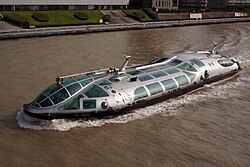
The Tokyo Cruise Ship Company operates a series of Water Bus ferries along the Sumida River and in Tokyo Bay, connecting Asakusa, Hinode, Harumi そして お台場。 The ferries feature a recorded tour announced in English as well as Japanese and a trip on one makes for a relaxing, leisurely way to see the waterfront areas of Tokyo. The super-futuristic Himiko ferry, designed by anime and manga creator Leiji Matsumoto, runs on the Asakusa-Odaiba Direct Line. You might want to arrive well before the departure time just in case tickets on the Himiko sell out!
自転車で
Bicycles are very commonly used for local transport, but amenities like bicycle lanes are rare, drivers pay little heed to bikes and traffic can be very heavy on weekdays, so if you use a bicycle, do not be afraid to cycle on the sidewalk (everyone does). Parts of Tokyo are surprisingly hilly, and it's a sweaty job pedaling around in the summer heat. Central Tokyo can still be covered fairly comfortably by bike on the weekends. Tokyo Great Cycling Tour offers a one-day guided tour for biking around major tourist spots in Tokyo, like Marunouchi, Nihonbashi, Tsukiji, Odaiba, Tokyo tower, Imperial palace and so on.
Parking your bicycle becomes a challenge in Tokyo, especially in the downtown area where you need to pay for parking and cannot simply leave the bike by a store/restaurant/shrine entrances on the sidewalk. Keep this in mind with renting a bicycle in dense urban areas of Japan.
Renting a bike is possible from some youth hostels, particularly around Asakusa, although it's not common. However, buying a simple single-speed roadster is fairly cheap, and comes complete with a built-in bicycle wheel lock system (this is what most Tokyoites use). An imported multiple-geared bike will be much more expensive so get a good lock, as bike theft is a common threat, although the problem is nowhere near as serious as in other countries.
Bicycle rentals are common around all of Japan and increasingly so in the more rural areas at train stations.
For rentals in the Tokyo area GS Astuto cycle shop has a full range of rental bikes geared at regular cyclists who primarily ride road bikes. GS Astuto can also deliver bikes to your hotel where you will stay.
Another option is to choose a cycling tour with a company. This can be a great way to get on a bike and see the best parts of Japan by bicycle. Within Tokyo Soshi's Tokyo Bike Tour, Tokyo Great Cycling Tour、および Bicycle Tours Tokyo offer day tours of popular sites within central Tokyo by bike. For an escape into the rural edges of Tokyo Bike Tour Japan takes guests on week long cycling adventures in the countryside just 1-2hrs from central Tokyo.
徒歩で
In this large city with such an efficient public transportation system, walking to get from point A to point B would seem a bit stupid at first glance. However, as the city is extremely safe even at night, walking in Tokyo can be a very pleasant experience. In some areas, walking can be much shorter than taking the subway and walking the transit (the whole Akasaka/Nagatacho/Roppongi area in the center is for instance very easily covered on foot). If you have the time, Shinjuku to Shibuya via Omotesando takes roughly one hour, Tokyo Station to Shinjuku would be a half a day walk, and the whole Yamanote line Grand Tour takes a long day.
見る
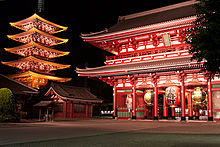


Tokyo has a vast array of sights, but the first items on the agenda of most visitors are the temples of Asakusa, the gardens of the Imperial Palace (in Chiyoda) and the Meiji Shrine (明治神宮 Meiji-jingū、で Harajuku).
Tokyo has many commercial centres for shopping, eating and simply wandering around for experiencing the modern Japanese urban phenomenon. Each of these areas have unique characteristics, such as dazzling 新宿, youthful 渋谷区 and upmarket 銀座。 These areas are bustling throughout the day, but they really come into life in the evenings.
If you're looking for a viewing platform, Tokyo has plenty of options:
- ザ・ Tokyo SkyTree (¥2,060-3,090) is Tokyo's latest attraction, not to mention it's also the second-tallest structure in the world, soaring to more than 2000 feet above the ground. However, its location away from downtown means the view is a distant jumble of buildings.
- The more familiar Tokyo Tower is still around. At ¥820-1,420, it's not as expensive as its newest rival, but neither is the view as good as some alternatives.
- For a view that's light on your wallet, head to the Tokyo Metropolitan Government buildings (in effect, Tokyo's City Hall) in 新宿。 Its twin towers have viewing platforms that are absolutely free, and offer a great view over Tokyo and beyond.
- ザ・ World Trade Center Building (10:00-20:00, or 21:00 in July and August, ¥620) at JR Hamamatsucho station offers stunning views of Tokyo Tower and the waterfront due to its excellent location, especially at dusk.
- Tokyo City View has an observation deck with great views of Tokyo Bay and downtown Tokyo including the nearby Tokyo Tower – admission is a steep ¥1,800-2,300, but includes admission to the Mori Art Museum.
- ザ・ Rainbow Bridge linking Tokyo to お台場 is another good option, if you don't mind traffic noise and smell. The bridge's pedestrian walkways (open until 20:00 at night) are free, and the night-time view across Tokyo Bay is impressive.
- ザ・ Bunkyo Civic Center next to the Tokyo Dome, dubbed by one newspaper as a "colossal Pez candy dispenser", has a free observation deck on the 25th floor offering an iconic view of Shinjuku against Mt. Fuji on a clear day.
The city is dotted with museums, large and small, which center on every possible interest from pens to antique clocks to traditional and modern arts. Many of the largest museums are clustered around 上野。 At ¥500 to ¥1,000 or more, entrance fees can add up quickly.
Riding Sky Bus Tokyo, an open-top double-decker operated by Hinomaru Limousine (every hour between 10:00 and 18:00), is a good option to take a quick tour around the city center. The 45 minutes bus ride on the "T-01 course" will take you around the Imperial Palace via Ginza and Marunouchi district, showing the highlight of Tokyo's shopping and business center. The fare is ¥1,500 for adults of 12 years old and over, and ¥700 for children between 4 and 11 years old. You can borrow a multi-language voice guide system free of charge upon purchasing a ticket, subject to stock availability. Four other bus courses are offered, including a night trip to Odaiba, but those trips are conducted in Japanese with no foreign language guidance.
Other tour companies catering to foreign tourists offer bus tours with English guidance – JTB is an excellent example.
行う
- を参照してください tuna auction at the Toyosu Market and eat a sushi breakfast at the former Tsukiji Fish Market.
- Take a boat ride on the Sumida River から Asakusa.
- Lose yourself in the dazzling neon jungle outside major train stations in the evenings. 渋谷区 and east 新宿 at night can make Times Square or Piccadilly Circus look rural in comparison — it has to be seen to be believed.
- Enjoy a soak in a local "sento" or public bath. Or one of the onsen theme parks such as LaQua at the Tokyo Dome (Bunkyo)または Oedo Onsen Monogatari に お台場.
- Go to an amusement park such as Tokyo Disney Resort, which consists of Tokyo Disneyland そして Tokyo DisneySea which are Asia's most visited (in Urayasu City Chiba) and second most visited theme parks respectively, or the more Japanese Sanrio Puroland (in Tama), home to more Hello Kitties than you can imagine.
- Join and bar hop or pub crawl along with events groups in Roppongi,
- Check out the hip and young crowd at Harajukuの Takeshita-Dori (Takeshita Street) or the more grown up Omotesando.
- In the spring, take a boatride in 吉祥寺's lovely Inokashira Park, and afterwards visit the Ghibli Studios Museum (well known for their amazing movies, like Spirited Away, and Princess Mononoke), but you will need to buy tickets for these in advance at a Lawson convenience store.
- Take the Yurikamome elevated train across the bay bridge from Shimbashi station to the bayside お台場 district, and go on the giant ferris wheel — at one time the largest in the world.
- Watch a baseball game, namely the Yomiuri Giants at the Tokyo Dome, or the Tokyo Yakult Swallows at Jingu Stadium. Nearby Chiba hosts the Chiba Lotte Marines.
- Take a stroll through the Imperial Palace's East Gardens (open to the public daily at 09:00, except Fridays and Mondays).
- Have a picnic in a park during the cherry blossom (Sakura). Unfortunately Sakura only lasts for about a week in Spring. But be warned, parks are usually very crowded during this time.
- Join a local for a short lunch or dinner homestay with Nagomi Visit's home visit program or participate in their cooking classes.
- Raising a glass in this colourful nightlife at 新宿 district.
- Joining the Harajuku's eccentric fashion tribes as they shop.
- Losing yourself in the vestiges of the old city Yanesen.
- 秋葉原 — Venturing into the belly of pop culture beast.
Festivals
- Sanja Matsuri (三社祭), third weekend in May. Tokyo's largest festival, held near Sensoji Temple in Asakusa, this three-day extravaganza sees up to 2 million people turn out to watch the parade of portable shrines (mikoshi) with music, dancing and geisha performances.
- Sumidagawa Fireworks Festival (隅田川花火大会 Sumidagawa Hanabi Taikai), fourth Saturday in July. Huge fireworks competition that sees up to a million people line the banks of the Sumida River.
学ぶ
The curious can study traditional culture such as tea ceremony, calligraphy, or martial arts such as Karate, Judo, Aikido and Kendo. There are also many language schools to help you work on your Japanese. Several universities in Tokyo cater to international students at the undergraduate or graduate level.
Universities
- Keio University (慶應義塾大学 Keiō Gijuku Daigaku) - Japan's top private university (unless you ask a Waseda student). Established in the samurai days of yore and has a stuffier rep than Waseda, with alumni including former prime minister Junichiro Koizumi. Main campus in Mita.
- Sophia University (上智大学 Jōchi Daigaku) - A prestigious private, Jesuit university well known for its foreign language curriculae and large foreign student population. Main campus in Yotsuya.
- Tokyo Institute of Technology (東京工業大学 Tōkyō Kōgyo Daigaku) - Tokyo's top technical university. Main campus in Ookayama.
- University of Tokyo (東京大学 Tōkyō Daigaku) - Japan's uncontested number one university, especially strong in law, medicine and literature. For locals, passing the entrance exams is fiendishly difficult, but exchange students can enter much more easily. Five campuses are scattered around the city, but the main campus is in Hongo.
- Waseda University (早稲田大学 Waseda Daigaku) - Japan's top private university (unless you ask a Keio student), famous as a den of artists and partiers. Former prime minister Yasuo Fukuda is an alum. Main campus in Waseda.
Work
Teaching English (or to a lesser extent, other foreign languages) is still the easiest way to work in Tokyo, but the city also offers more work options than other areas of the country: everything from restaurant work to IT. Certain nationalities are eligible for working holiday visas: for others, work permits can be very hard to come by without a job offer from a Japanese company. Consult your local Japanese consulate/embassy as far in advance as possible.
購入

Tokyo is one of the fashion and cosmetic centers in the Eastern world. Items to look for include electronics, funky fashions, antique furniture and kimono, as well as specialty items like Hello Kitty goods, anime and comics and their associated paraphernalia. Tokyo has some of the largest electronic industries in the world, such as Sony, Panasonic, and Toshiba etc.
Cash payment is the norm. Most Japanese ATMs do not accept foreign cards, but post office, 7-Eleven and ones from large banks do and usually have English menus as well (Mitsubishi-UFJ ATMs accept UnionPay and Discover card users, while Mitsui-Sumitomo allows the use of UnionPay cards for a ¥75 surcharge regardless of time of day). Most ATMs only give ¥10,000 notes (such as 711 and convenience stores). However, some ATMs do give ¥1,000 notes (at the airport and large banks). Although クレジットカード are more and more widely accepted, they are far less widespread than in most other developed countries. The crime rate is very low, so don't be afraid of carrying around wads of cash as the Japanese do. The average Japanese citizen will carry a month's worth of expenses on them (around ¥40,000 give or take).見る 購入 under 日本 for general caveats regarding electronics and media compatibility.
There are numerous convenience stores throughout Tokyo (such as Seven-eleven, Lawsons, and Family-Mart), which are open around the clock and sell not only food and magazines, but also daily necessities such as underwear and toiletries. Supermarkets are usually open until 22:00, while drugstores and department stores usually close at 21:00.
Anime and manga
秋葉原, Tokyo's Electric Town, is now also the unquestioned center of its otaku community, and the stores along Chuo-dori are packed to the rafters with anime (animation) and manga (comics).Another popular district for all things manga/anime is the 中野 ward and its Broadway Shopping arkade. Check out the mandarake shop for loads of used and rare mangas.
There has been an "otaku boom" in Akihabara. A lot of attention in particular was paid to the town thanks to the popular Japanese drama "Densha Otoko", a (true) love story about an otaku who saves a woman from a molester on a train and their subsequent courtship.
Akihabara was previously known for its many live performances and cosplayers, some of which had drawn negative attention due to extremist performers. These have become increasingly scarce following the Akihabara massacre in 2008, although girls in various maid costumes can still be seen standing along the streets handing out advertisement fliers to passers by for Maid Cafes.
If you like a specific anime or character. Tokyo has no shortages of official stores dedicated to a specific character or anime series
骨董品
Serious collectors should head for the Antique Mall に 銀座 または アンティークマーケット に Omotesando, which despite the rustic names are collections of small very specialist shops (samurai armor, ukiyo-e prints, etc.) with head-spinning prices. Mere mortals can venture over to Nishi-Ogikubo, where you can pick up scrolls of calligraphy and such for a few thousand yen.
ザ・ Antique Festival (全国古民具骨董祭り) is held over the weekend about 5-6 times a year at the Tokyo Ryutsu Center, on the Tokyo Monorail line, and is well worth a visit.
Books
Jinbocho is to used books what Akihabara is to electronics. It's clustered around the Jinbocho subway stop.The Blue Parrot is another shop at Takadanobaba on the Yamanote line, just two stops north of Shinjuku.
Cameras and electronics
Ever since Sony and Nikon became synonymous with high-tech quality, Tokyo has been a favored place for buying electronics and cameras. Though the lines have blurred since the PC revolution, each has its traditional territory and stores: 秋葉原 has the electronics stores, including a large number of duty-free shops specializing in export models, and 新宿 has the camera stores. Unfortunately, local model electronics are not cheap, but the export models are similar to what you'll pay back home. you can sometimes find cheap local models if you avoid big shops and check smaller retailers. It's also surprisingly difficult to find certain things e.g. games machines.
Fashion
渋谷区 and neighboring Harajuku are the best-known shopping areas for funky, youthful clothes and accessories. Almost without exception, clothes are sized for the petite Japanese frame.
Department stores and exclusive boutiques stock every fashion label imaginable, but for global labels prices in Tokyo are typically higher than anywhere else in the world. The famous 銀座 そして Ikebukuro's giant Seibu そして Tobu department stores (the largest in the world) are good hunting grounds. Roppongi Hills has emerged as a popular area for high-end shopping, with many major global brands. Other department stores in Tokyo are Mitsukoshi, Sogo, Marui (OIOI), Matsuzakaya, Isetan, 松屋 そして Takashimaya。 Mitsukoshi is Japan's biggest department store chain. Its anchor store is in Nihonbashi, and is particularly known for its premier kimono department. Marui Men store in 新宿 has eight floors of high-end fashion for men only.
Kitchenware
The district for this is Kappabashi Street 近く Asakusa, also known as “Kitchen Town.” The street is lined with stores selling all kinds of kitchen wares — this is where the restaurants of Tokyo get their supplies. It's also a great place to find cheap Japanese ceramics, not to mention plastic food!
Music
Ochanomizu is to the guitar what Jinbocho is to used books. There, you'll find what must be the world's densest collection of guitar shops. Plenty of other musical instruments (though not traditional Japanese ones) are also available.
Souvenirs
For touristy Japanese knickknacks, the best places to shop are Nakamise に Asakusa そしてその Oriental Bazaar に Omotesando, which stock all the kitschy things like kanji-emblazoned T-shirts, foreigner-sized kimono, ninja outfits for kids and ersatz samurai swords that can be surprisingly difficult to find elsewhere. Both also have a selection of serious antiques for the connoisseur, but see also 骨董品 above.
Street markets
Bustling open-air bazaars in the Asian style are rare in Tokyo, except for 上野の Ameyoko, a legacy of the postwar occupation. Yanaka Ginza in the Shitamachi Taito district, a very nice example of a neighborhood shopping street, makes for an interesting afternoon browse.
There are often small flea and antique markets in operation on the weekend at major (and minor) shrines in and around Tokyo.
食べる
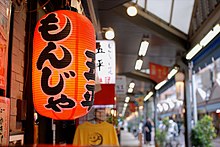
Visitors from Western countries may be surprised to find that despite its justified reputation for being an expensive city, eating out in Tokyo can be surprisingly affordable. While fine dining establishments in Tokyo can be some of the most expensive in the world, at the budget end of the spectrum, it is fairly easy to find a basic rice or noodle joint serving up meals starting from ¥300; a price that is unmatched even by McDonald's or other fast food chains in the West.
Tokyo has a large quantity and variety of food. Department stores have food halls, typically in the basement, with food which is comparable to top delicatessans in other world cities (though mostly Japanese and Japanized foreign food). Some basements of train stations have supermarkets with free taste testers. It's a great way to sample some of the strange dishes they have for free.Tokyo has a large number of restaurants, so see the main 日本 guide for the types of food you will encounter and some popular chains. Menus are often posted outside, so you can check the prices. Some shops have the famous plastic food in their front windows. Don't hesitate to drag the waiting staff out to the front to point at what you want. Always carry cash. Many restaurants will not accept credit cards.
Tokyo has tens of thousands of restaurants representing many cuisines in the world, though sometimes adjusted for local tastes, but it also offers a few unique local specialties. Within Japan, Tokyo cuisine is best known for 3 dishes: sushi, tempura, and unagi (freshwater eel). Nigirizushi (fish pressed onto rice), known around the world around simply as "sushi," in fact originates from Tokyo, and within Japan is known as Edo-mae zushi (Edo-style sushi). Another is monjayaki (もんじゃ焼き), a gooey, cabbage-filled version of okonomiyaki that uses a very thin batter to achieve a sticky, caramelized consistency. It is originally from the Tsukishima area of Chuo and today there are many restaurants near Asakusa offering monjayaki.
- Hot Pepper Available in various editions, by region, around Tokyo, this free magazine offers a guide to local restaurants in Japanese but provides pictures and maps to the restaurants. Some restaurants even offer coupons. Most restaurants within this magazine are on the mid-range to high end scale.
予算
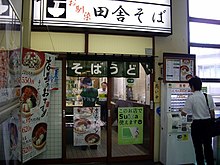
Go to a convenience store (konbini), there is one on every second corner. Really, the options may surprise you. You can get rice balls (onigiri), bread-rolls, salads, prepared foods (like nikuman そして oden), and drinks (both hot and cold) for ¥100-150, bentō lunch boxes for around ¥500 and sandwiches for ¥250-350. At most convenience stores, microwaves are available to heat up your food for no additional cost. Supermarkets (sūpā) are usually cheaper and offer a wider choice, but are more difficult to find. (Try Asakusa and the sidestreets of Ueno's Ameyoko market for local—not big chain—supermarkets.). LIFE supermarket is a good place to buy discount food after 20:00 Also, ¥100 shops (hyaku-en shoppu) have become very common, and most have a selection of convenient, ready to eat items. There are ¥100 shops near most minor train stations, and usually tucked away somewhere within two or three blocks of the big stations. In particular, look for the "99" and "Lawson 100" signs; these chains are essentially small grocery stores.
Also, look for bentō shops like Hokka-Hokka-Tei which sell take-out lunch boxes. They range in quality and cost, but most offer good, basic food at a reasonable price. This is what students and office workers often eat.
Noodle shops, curry shops, and bakeries are often the best option for people eating on the cheap. They are everywhere.ザ・ noodle bars on every corner are great for filling up and are very cheap at ¥200–1000. You buy your meal ticket from a vending machine at the door with pictures of the dishes and hand it to the serving staff. The one question you will typically have to answer for the counterman is whether you want soba (そば) (thin brown buckwheat) or udon (うどん) (thick white wheat) noodles. Some offer standing room only with a counter to place your bowl, while others have limited counter seating. During peak times, you need to be quick as others will be waiting. Pseudo Chinese-style ramen (ラーメン) (yellow wheat and egg noodles) are a little more expensive and typically sold in specialist shops, with prices starting from ¥400, but are typically served in very flavourful pork or chicken broth that has been boiled overnight. Tokyo is generally known among the Japanese for shoyu ramen, in which soy sauce is used to add flavour to the pork broth.
Fast food is available just about everywhere, including many American chains like McDonald's and KFC. But if you are visiting Japan from overseas, and wish to sample Japanese fast food, why not try MOS Burger, Freshness Burger, Lotteria, or First Kitchen? If you're looking for something more Japanese, try one of the local fast food giants, 松屋, 吉野家、および Sukiya, which specialize in donburi: a giant bowl of meat, rice, and vegetables, sometimes with egg thrown in for good measure, starting at below ¥300 for the flagship gyūdon (beef bowl). Another good option is oyako don (chicken and egg bowl, literally “mother and child bowl”), which the somewhat smaller chain Nakau specializes in. Drinking water or hot ocha (Japanese green tea) is usually available at no extra cost. There are also a number of tempura chains, with some budget options. More upscale but still affordable and rather more interesting, is Ootoya, which serves up a larger variety of home-style cooking for under ¥1000. Yayoi-ken is a chain of eateries serving 定食, complete set meals: buy a ticket from the machine, and you'll get miso soup, main course (fish or meat, often with vegetables), rice (bottomless, just ask for refills), a small hunk of fresh tofu, pickles and tea, and still be left with some change from your ¥1000.
Raw fish enthusiasts are urged to try kaitenzushi (conveyor belt sushi), where the prices can be very reasonable. Prices do depend on the color of the plate, however, and some items are very expensive, so be sure to check before they start to pile up.
A great option for a quick bite or for groups is yakitori (grilled chicken) – individual skewers are often below ¥100.
Many of the larger train and subway stations have fast, cheap eateries. Around most stations, there will be ample choices of places to eat, including chain coffeeshops (which often serve sandwiches, baked goods, and pasta dishes), yakitori places, and even Italian restaurants.
ミッドレンジ
There are a great many excellent and affordable lunch choices in busier neighborhoods like Shibuya and Shinjuku, especially during the week – expect to spend about ¥1000 (without drinks) for a meal.
By tradition the basement of almost any department store, including Mitsukoshi, Matsuzakaya, or Isetan, is devoted to the depachika (デパ地下), a huge array of small shops selling all kinds of prepared take-out food. You can assemble a delicious if slightly pricey picnic here – or, if you're feeling really cheap, just go around eating free samples! The very largest department stores are Tobu and Seibu in Ikebukuro, but 渋谷区, 銀座 and in fact any major Tokyo district will have their fair share. 新宿 Station is home to several famous department stores, such as the Keio and Odakyu department stores. Many stores begin discounting their selections at about 19:00 each night. Look for signs and stickers indicating specific yen value or percentage discounts. You will often see half-price stickers which read 半値 (hanne)。 This discounting is also common at supermarkets at the smaller stations, although the quality may be a notch or two down from the department stores, it's still perfectly edible.
The ubiquitous izakaya, a cross between a pub and a casual restaurant, invariably serve a good range of Japanese dishes and can be good places to fill up without breaking the bank: in most, an evening of eating and drinking won't cost more than around ¥3000 per person.見る ドリンク for details.
There is a great variety of restaurants serving Tokyo's world-famous sushi at every price point, with fish fresh from Toyosu, the world's largest fish market. It is possible to get sushi for as little as ¥100/piece or less (at chain stores), or spend upwards of ¥10,000 yen (at elegant Ginza restaurants), but a typical spend is ¥3000–¥4000, depending on selection (drinks extra). Usually omakase (chef's choice) gives a good deal and selection, to which you can add a piece or two a la carte if desired. A popular choice with tourists is a sushi breakfast at Tsukiji, former home of the fish market, particularly for one's jet-lagged first morning, or after a night out partying. Most sushi shops in the outer market of Tsukiji open at 8 or 9AM, though there are some 24-hour shops, and particularly popular are two small stores in the inner market that open before 6AM and feature market ambience and very long queues; see Chuo: Mid-range dining.
The best-known tempura chain is Tsunahachi, where depending on the store you can pay from below ¥1000 for lunch to over ¥6000 for dinner.
A classic modern Japanese dish is tonkatsu (“pork cutlet”), and there are good Tokyo options; the fattier loin (ロース “roast”) is generally considered tastier than the leaner fillet (hire ヒレ). The most famous restaurant is Tonki, right by Meguro station (1-1-2 Shimo-Meguro, Meguro-ku, Tokyo), serving a standard meal at about ¥1600, dinner only (from 16:00). While it is an institution with a loyal clientele (and frequent lines), and decidedly has atmosphere (similar to an established New York deli), the food gets mixed reviews, and is less succulent than other options – an interesting experience, however. Next most famous is the chain Maisen (まい泉), which serves delicious if somewhat expensive tonkatsu (various varieties and seasonal options) at many locations in Tokyo, most notably at their flagship shop in Aoyama by Omotesandō station (Jingumae 4-8-5, closing at 19:00). The top-end dish is Okita Kurobuta (Berkshire pork by Mr. Okita), at ¥3,800 for a meal, though they have cheaper options. A modern option is Butagumi, at Nishi-Azabu 2-24-9 (west of Roppongi station), serving a variety of premium pork brands expertly prepared.
Tokyo also has a large number of Korean restaurants, generally midrange, and many yakiniku (grilled meat) restaurants are Korean-influenced.
Splurge
Tokyo has the world's highest number of Michelin-starred restaurants, with prices to match. For upmarket Japanese eats, 銀座 is guaranteed to burn a hole in your wallet, with Akasaka そして Roppongi Hills close behind. Top-end restaurants are primarily Japanese, with a few French. Tokyo is widely regarded as the spiritual home of a fine style of sushi known as edomae-zushi (江戸前寿司). Besides sushi, Tokyo's fine dining scene also includes Japanese contemporary, tempura and 懐石。 You can limit the damage considerably by eating fixed lunch sets instead of dinner, as this is when restaurants cater to people paying their own meals instead of using the company expense account.しかし、ほとんどの施設は新規顧客からの予約を受け付けていないため、東京の高級ダイニングシーンは外国人観光客がアクセスできないことで有名です。そこで食事をするためには、彼らの通常のダイナーの一人から紹介される必要があります。とは言うものの、何ヶ月も前に予約すれば、ホテルのコンシェルジュを通じてこれらの施設のいくつかのスポットを予約することができますが、これを行うために必要な影響力を持っているのは最も高価な高級ホテルだけです。また、多くの高級ダイニング施設はクレジットカードを受け付けておらず、食事代を支払う必要があることにも注意してください。 現金で.
東京には3つ星の寿司屋が4つあり、その中で国際的に最も有名なのはすきやばし次郎です。家)、映画のため 二郎は鮨の夢; 前月1日は当日予約で、夕食は3万円から。これらのトップ寿司レストランの中で最も安いのは鮨さいとう寿司(81 3 3589 4412)で、わずか5,000円で簡単なランチを楽しむことができます。
ドリンク

パーティーは東京(少なくともカラオケバー)で止まることはなく、どこにでも良い小さなバーやレストランがあります。
個人または小グループで夜を過ごす最も日本の方法は、日本式の水飲み場と呼ばれる場所です。 居酒屋 (居酒屋)は、陽気なパブのような雰囲気の中で食べ物や飲み物を提供します(を参照してください) 日本 詳細については)。より安いチェーン 居酒屋 お気に入り つぼ八 (つぼ八)と シロキヤ (白木屋)は通常、写真メニューがあるので、日本語がわからなくても注文は簡単ですが、日本語のみのタッチスクリーン注文システムがある場所もありますが、驚かないでください。
外国人の耳には信じられないことが多いもう一つの一般的な選択肢は、「飲み放題」(のみほだい、 飲み放題)、固定メニューから90分または120分飲み放題。これはグループパーティーを対象としており、通常は「食べ放題」の食事と組み合わせて使用します(タベホダイ、 食べ放題)、しばしば個室で。注文されたアイテムを受け取るかどうかは、サーバーがこれらのアイテムを持ち出すことを決定する頻度によって異なります。つまり、ある程度「スロットル」され、本当の「飲み放題」の体験とは言えない場合があります。これは設立によって異なります。 300円以下でドリンクが買える安いバーもたくさんあります。
東京で一番特徴的な飲み物は ホッピー (ホッピ、 ホッピー)は、実質的に非アルコールのビール風味の飲み物(0.8%アルコール)で、焼酎(25%)と5:1の比率で混合して飲むと、約5%のアルコール飲料、本質的には代替ビールになります。これは古い居酒屋で利用可能で、特においしいわけではありませんが、最近レトロな復活を経験しています。もう1つの特徴的な東京の飲み物は、電気ブラン(電気ブラン、「電気ブランデー」)です。これは、神谷バー(神谷バー)で(ボトルの中またはボトルで飲む)ハーブ風味のブランデーです。 浅草、地下鉄駅のすぐそばの主要交差点。
主要なブランドのビールは広く入手可能で、通常はグラスまたはボトルあたり500〜800円ですが、地ビールや外国のビールはめったに入手できず、非常に高価なことがよくあります。一般的に、専門店で地ビールのボトルを入手する方が良いでしょう。 ポパイ 両国では珍しい例外で、70本のビールが出ています!もう1つの人気のある選択肢は、恵比寿のビールステーションで、さまざまなヱビスビールとそれに合うドイツ料理を提供しています。
西新宿のパークハイアット東京には、52階にニューヨークバーがあります。東京の昼夜を問わず素晴らしい景色を眺めることができ、映画の舞台にもなりました。 ロストイントランスレーション。ここでのカクテルは1400円前後から始まり、シングルモルトウイスキーは2000円以上です。 4〜6杯の「テイスティングフライト」で提供される素晴らしいカクテルは、 山本元 麻布十番の彼のバーでは、6ドリンクで約6000円(アラカルトカクテルは1600円から1800円で大量に提供されます)。
クラブやライブハウスへの訪問は高額になる可能性があり、クラブやライブハウスでは週末のカバーチャージが2000〜5000円(通常はドリンククーポン1〜2枚が含まれます)になります。
あなたが町で新しいなら、 六本木 外国人向けのサービスを専門とする施設がありますが、外国人、ホステス、「常連客」が溢れ、5000円以上の飲み物が並ぶ紳士クラブに足を運びます。多くの日本人と外国人はこのエリアを避け、クラブやバーを好みます 渋谷区 代わりに、またはトレンディ 銀座, 恵比寿、または 新宿.
ハブ英国スタイルのパブのチェーンである、に支店があります 新宿, 渋谷区、および 六本木 (そしてほとんどの主要な駅の近く)そして手頃な価格で外国人と日本人の間で同様に人気があります。その他の英国/アイルランドのパブは、六本木、新宿、渋谷にあります。ハッピーアワーで数百円も安くなりますが、1パイント1000円程度の支払いが見込まれます。
に 渋谷区、109の後ろ(109-2ではない)と道玄坂(「ラブホテルヒル」)の隣のバーエリアには、たくさんのクラブがあります。六本木や渋谷のガスパニックとは異なり、入場料がかかりますが、入場料のないクラブは一晩中飲み物を買うのが面倒で、実際に音楽を楽しむ人がいなくても同じくらい高価になります。 新宿 日本最大の歓楽街、歌舞伎町があります。また、新宿には新宿二丁目のゲイバー地区があります。市内中心部から少し離れたところにあります 下北沢, 高円寺 そして 中野、学生や20/30代に人気のアンダーグラウンド/インディーズ音楽を提供する、おいしいバー、レストラン、「ライブハウス」がたくさんあります。
睡眠
東京エリアには、安いホテルから非常に高いホテルまで、何千ものホテルがあります。それらは街中に分布しており、ハイエンドとローエンドのいくつかはほとんどどこにでもあります。多くの洋風ホテル、特にアメリカのホテルチェーンと提携しているホテルには、英語を話すスタッフがいます。
東京の不動産価格は世界で最も高く、この地域のアパートは一般的に非常に窮屈なので、長期の宿泊施設については、贅沢な準備をしてください。多くの地元の人々は実際に近隣の都市に住んでいて、東京の天文学的な家賃のために毎日仕事のために東京に通勤しています、そして片道の通勤時間はしばしば2時間以上続くことがあります。
予算
東京の手頃な宿泊施設の多くは、 台東 エリア、特に 浅草 そして 上野。しかし、中心から少し外れることを恐れていない場合は、周囲を見ることができます。 横浜、など。
台東エリア(JR南戦場の近く)の格安宿泊施設のほとんどは22:00〜23:00の夜間外出禁止令がありますので、気になる場合は事前に確認してください。門限のないホテルの1つは カンガルーホテル、お部屋は3200円から。もあります エコノミーホテルホテイヤ、お部屋は2700円から。
カプセルホテルは一般的に最も安いオプションです。説明するのが難しいかもしれない行動のルールがかなりあるので、彼らは外国人をホストすることに気が進まないかもしれません。を参照してください 日本 フルスクープの記事。ほとんどのカプセルホテルは男性専用です。 秋葉原カプセルイン 女性専用フロアを持つ数少ないホテルの1つです。
東京では、マンガキサと呼ばれる24時間営業のコミックライブラリー/インターネットカフェが一般的です。これは、終電に乗り遅れて早朝のトランジットサービスが開始されるのを待つ必要がある場合にクラッシュする最も安価な方法の1つです。ベッドはありませんが、快適な椅子と、眠れない場合はPCやDVDがあります。夜遅くになると、カラオケボックスは一晩中割引価格で提供されることが多く、通常は寝ることができるソファがあります。これらのサイバーカフェのほとんどは、8時間で1500〜2500円かかります。
最も安い滞在方法の1つは、ユースホステルでもあります。料金は、1200円からです。の中に 新宿 範囲。
あなたがいる場合 本当に 予算内で、ホームレスになることが可能であり、 キャンプ 公共の公園で、無料で。テントを持ち歩きたい場合はテントでこれを行うことができます。また、疲れ果てたサラリーマンや学生と同じように、ベンチで寝ることもできます。日本全土でこれを行うことも可能です。することによって のじゅく (日本人はそれを呼んでいます)そしてコンビニエンスストアで食事をしたり、スーパーマーケットで買った食べ物から自分でサンドイッチを作ったりすると、ネパールのカトマンズと同じくらいの価格で東京に滞在できます!
ミッドレンジ
ホテルには幅広い選択肢がありますが、東京ではほとんどのホテルが3つ星以上の評価を受けています。東京は、サービスとホテルの場所が最高であるため、ホテルに関しては他のほとんどの都市の1つです。
と呼ばれるものに目を光らせてください ビジネスホテル。部屋は通常狭いですが、駅の近くにあり、料金は6000円前後からです。スタッフは最小限の英語を話すかもしれませんが、理解するのはそれほど難しいことではありません。これらは一人旅に最適なオプションです。東京中にある手ごろな価格のチェーンには、 東急ステイ、無料のインターネットアクセスと朝食を提供し、 ちすん そして サンルート.
東京には自称があります 旅館 (旅館)主に外国人観光客向けで、主に周辺に集中している 上野 そして 浅草。本物ほど豪華ではありませんが、手頃な料金で日本の家庭生活のサンプルを提供しています。
日本の悪名高い ラブホテル 東京では合理的な(そして興味深い)選択肢になる可能性があります。渋谷の 道玄坂 (「ラブホテルヒル」)は、市内で最も幅広い選択肢を提供しています。本当に夜を過ごすつもりなら、必ず「休憩」ではなく「滞在」をチェックインしてください。一部のラブホテル(少なくとも新宿周辺)には、おそらく請求に関する混乱を避けるために、「日本人なし、滞在なし」のポリシーがあることに注意してください。他の人はあなたが去るためにドアのそばのスロットに支払うまであなたをあなたの部屋に閉じ込めます。
1週間以上滞在する予定の場合は、お試しください ウィークリーマンション東京[リンク切れ]。これらは、手頃な価格で短期間借りることができるアパートです。料金はお一人様1日5000円程度、お二人様はもう少しです。 1日4000円程度のお得な情報が見つかることもあります(オンライン予約ではさまざまなプロモーション情報を利用できます)。英語でオンライン予約することもできます。
Splurge
あなたは東京の宿泊施設に大金を費やすことができます。ハイエンドの国際チェーンのほとんどはよく表されています。高級ホテルの特定の集中は西部で見つけることができます 新宿 (パークハイアット東京を含む、 ロストイントランスレーション)、東京駅周辺(ここがベスト シャングリ・ラホテル東京。マンダリンオリエンタル、ペニンシュラホテル、帝国ホテル東京、誠陽銀座、フォーシーズンズ丸の内)、 赤坂.
「東京湾」にあると宣伝しているホテルには注意してください。せいぜい、これはあなたが中または近くにいることを意味します お台場 市の中心部から30分離れた埋め立て地に建てられた地区。最悪の場合、隣接する都道府県の海岸のどこかに行き着くでしょう 千葉、訪問するのに便利です 東京ディズニーランド しかし、東京自体をツアーするのはかなり不便です。
接続する
無料のWifi
- 東京メトロ 約100のメトロ(JRではない)ステーションで無料Wi-Fiを利用できます。SSIDは「Metro_Free_Wi-Fi」または「Toei_Subway_Free_Wi-Fi」で、メール登録が必要です。
- 7スポット(日本語サイト) セブン-イレブンのコンビニエンスストアとデニーズのレストランでは、無料のWi-Fiサービスを提供しています。会員登録(無料)を利用する「7SPOT」は、1回のログインで最大60分まで使用でき、1日3回までアクセスできます。 登録ページ(日本語)
- FreeSpot 無料のワイヤレスインターネットアクセスを提供するFreeSpot、サービスエリアの地図をチェックしてください
- 無料Wi-Fiジャパン 日本への訪問者は、パスポートの提示により、NTT東日本無料Wi-Fiを最大14日間完全無料で使用できます。たった1つのIDで日本の半分で無料Wi-Fiを楽しむことができます。
有料Wifi
- ホットスポット NTT通信WiFiサービス。 500円/ 24時間
インターネットカフェ
どこのインターネットカフェでも接続が良好です。 1時間あたり400円から500円の支払いが見込まれます。 「ゲラゲラ」は人気チェーンです。有料WiFiサービスも東京で開始されており、リーズナブルなカバレッジで、価格も手頃です。 WiFiサービスは、訪問したばかりの人にはおそらく便利ではありません。
自分のコンピューターにWLANカードを持参すると、マクドナルドやモスバーガーなどのファーストフード店でワイヤレス接続を見つけることができます。また、数多くあるコーヒーショップの1つでつながりを見つける良いチャンスがあります。フロントウィンドウまたは店内のコンピューターでワイヤレス接続サインを探すだけです。無料のワイヤレスは、日本では欧米ほど普及していません。
携帯電話
外国人は使い捨ての「バーナー」携帯電話やSIMカードを購入することは禁じられていますが、携帯電話、SIMカード、ポータブルWi-Fiホットスポットを借りることは可能です。
- レンタフォンジャパン テキストメッセージ、通話、モバイルインターネットサービスを備えた基本的な携帯電話をレンタルします。
- eConnect 「WiFi-To-Go」モバイルホットスポットを1日432円から1,080円でレンタルし、データのみのプリペイドSIMカードを30日間使用できます。
おげんきで
東京はおそらくこれまで訪れた中で最も安全な大都市の1つであり、日本は一般的に世界で最も安全な場所の1つです。一人の女性旅行者を含むほとんどの人は、夜に一人で通りを歩いているときに問題に遭遇することはありません。街頭犯罪は、深夜でも非常にまれであり、減少し続けています。しかしながら、 「小さな犯罪」は「犯罪がない」という意味ではありません、そして常識はまだ世界のどこでも適用されるべきです。多くの場合、最大のリスクは、旅行者が日本の目に見える犯罪の欠如を心に近づけすぎて、家に帰ることは決してないことをすることです。
最も一般的な犯罪は、混雑した電車でのセクハラであり、お互いに押し付けられ、手がさまよう。西洋人はより攻撃的であると考えられており、彼ら自身のために固執するので、これはより局所的な問題です。さまよう手に対処する最良の方法は、「叫ぶことです」ちかん!「変態」の日本語の用語です。東京の主要鉄道駅の中には鉄道警察署があり、その場所を見つけることができます。 ここに。代わりに、で警察にダイヤルすることもできます ☏ 81-03-3581-4321 セクシャルハラスメントを報告する。
小さな警察署、または 交番 (交番)、数ブロックごとに見つけることができ、コミュニティポリシングを提供します。道に迷ったり、助けが必要な場合は、必ず彼らのところに行ってください。あなたを助けるのは彼らの仕事です!彼らは周辺地域の素晴らしい地図を持っており、道案内を喜んで提供します。ただし、英語が苦手な方もいらっしゃるので、日本語の知識があれば助かります。こうばんの人員は通常限られており、犯罪を通報する必要がある場合は、地図や標識に十字が付いた円でマークされた最寄りの警察署(警察署)に提出する必要があります。
混雑した場所や電車の中では、スリに対して通常の予防策を講じてください。また、旅行者や非居住者に人気のあるたまり場やバーで盗難が発生する可能性が高くなります。
赤信号とナイトライフ地区は少し怪しげですが、危険なことはめったにありません。歓楽街にあるいくつかの小さな裏通りの飲酒施設は、法外な価格を請求することが知られています。六本木の高級高級クラブでも同様の問題があり、事前にカバーチャージや飲み物の値段を確認するのが賢明かもしれません。
まだ渋滞中ですか?コール 東京イングリッシュライフライン、tel。 03-5774-0992、毎日09:00-23:00。
あなたがそれを遠くまで作るなら 伊豆諸島、への訪問者 三宅島 火山ガスのため、防毒マスクを携帯する必要があります。健康状態が悪い人は、島への旅行をお勧めしません。さらに、東京は、日本の他の地域と同様に、 地震.
対処
住所
東京では、他の日本の都市と同様に、場所の住所は実際にそこにたどり着くにはほとんど役に立たない。ほとんどの道路には名前がありません。アドレスは、大きいものから小さいものの順に書き込まれます。名駅4丁目5-6または名駅4-5-6と書かれた住所の例は、名駅(名駅)、地区(ちょめ)4、ブロック5、ハウス6。(住所は通常英語で「名駅4-5-6」または「4-5-6名駅」と表記されます。)階または部屋番号に追加の番号が追加される場合があります。
地区、ブロック、および家の番号付けは、多くの場合、連続していません。番号は通常、建物が建設されるときに、時系列で、または市内中心部からの距離に基づいて割り当てられます。街角近くの小さな看板は、区/近隣と地区を日本語で表示します(名駅4丁目、名駅四丁目など)。多くの場合、ブロック番号が含まれていますが、含まれていない場合もあります。その場合、地区は12ブロック以上になる可能性があるため、標識は非常に役に立ちません。建物の入り口には通常、ブロックと家番号(5–6など、5番6号と書かれることもあります)が表示されますが、地区は表示されません。
住所を見つけるには、区に向かい、街角近くの標識を探し始めます。ザ・ ちょめsは論理的な方法で番号を付けることができます— ちょめ 隣の4 ちょめ 3、またはそうではないかもしれません。正しいものを見つけたら ちょめ、ブロックを探し始めます。この場合も、ブロック5はブロック4の近くにある可能性があります。次に、ブロックを歩き回って建物6を探します。 ガンバッテ! (がんばろう。)
ヘルスケアセンター
- [リンク切れ]東京都保健医療情報センター, ☏ 81 3-5285-8181. 09:00-20:00. 日本の医療機関や医療・健康保険制度に関する情報。 (英語/中国語/韓国語/タイ語/スペイン語)。
- 緊急翻訳サービス(医療機関向け), ☏ 81 3-5285-8185. 平日:17:00〜20:00、平日・祝日:09:00〜20:00. 旅行者ではなく、医師が利用するサービスです。しかし、医師が英語を話さない場合は、医師があなたをよりスムーズに見ることができるように、このサービスについて医師に伝えたいと思うかもしれません。 (英語/中国語/韓国語/タイ語/スペイン語)。
ベビーシッター
- chezvous.
- キンダーネットワーク, ☏ 81 3-6415-8271, ✉[email protected].
- ベビーシッター, ☏ 81 45-507-1888, ✉[email protected].
アクセシビリティ
東京は日本で最もアクセスしやすい都市であり、ほとんどの観光名所とともに、90%以上の駅が車椅子でアクセスできます。電車での混雑は難しい人もいますが、車椅子スペースは利用できます。
アクセシブルなレストランを見つけるのは、階段がある場合や非常に小さいため、アクセスが難しい場合があります。デパートの最上階には、アクセスしやすいレストランがよくあります。
- アクセシブルな日本 -一般情報、バリアフリールームのあるホテルのリスト、観光スポット
- 日本ガイド:日本でアクセシブルな旅行の基本ガイド - 一般的な情報
大使館
|
|
次へ
東京から、周囲全体 関東 地域はあなたのカキです。近くの特に人気のある目的地は次のとおりです。
- 箱根 —温泉と景色 富士山、芦ノ湖。
- 川越 —「小江戸」とも呼ばれる旧市街。そのメインストリートと城はあなたを時代に戻すことができます。東京駅から電車で30分。
- 鎌倉 —数十の小さな寺院と1つの大仏の本拠地
- 日光 —徳川家康将軍の壮大な神社と埋葬地
- 小田原 —首都圏で唯一の日本の城があります
- 湯河原, 真鶴 —温泉や沿岸リゾート、食事 刺身 そして みかん、のビュー 真鶴半島、いくつかのお祭り(まつり)。
- 東京ディズニーリゾート —と 東京ディズニーランド (他の場所と同じように)そして 東京ディズニーシー (日本で唯一のテーマパークで、日本国外のディズニーパークからのユニークな乗り物と輸入された乗り物がいくつか含まれています)
- 横浜 —日本で2番目に大きな都市と東京の郊外
東京エリアには、東京中心部からの日帰り旅行が簡単な、あまり有名ではない目的地もいくつかあります。
- 足利 —有名な将軍一族の歴史的な故郷、日本で最初の学校、日本でトップのフラワーパーク、そして美しい自然
- 桐生 —日本の小さな町を味わいたいハイキングやサイクリング愛好家のための美術館と豊かな自然がある有名な歴史的なシルクの町
- 八王子 —さわやかな登山高尾は森を抜けて神社やビアガーデンへ
- カワサキ —毎年恒例の鉄ペニス祭り(かなまら祭)は言うまでもなく、24の古代の農家(思ったよりも面白い)がある日本民家園公園の本拠地
- 鬼怒川 —温泉街 日光、ホーム 江戸ワンダーランド日光江戸村、江戸時代を舞台にしたテーマパークで、美しい山の中に忍者、侍、芸者などのショーがあります。
- フジノ —芸術に興味があり、美しい景色を楽しむ地元の人にも外国人にも人気の小さな町
そして、東京の南にある島々を忘れないでください。
| 東京を通るルート |
| 新潟 ← 大宮 ← | N | → 終わり |
| 青森 ← 大宮 ← | N | → 終わり |
| 大阪 ← 新横浜 ← | W | → 終わり |
| 名古屋 ← 八王子 ← | W | → 終わり |
| 終わり ← | W | → 市川 → 成田 |
| いわき ← ミサト ← | N | → 終わり |
| 長岡 ← 所沢 ← | N | → 終わり |
| 青森 ← 浦和 ← | N | → 終わり |
| 名古屋 ← カワサキ ← | W | → 終わり |

